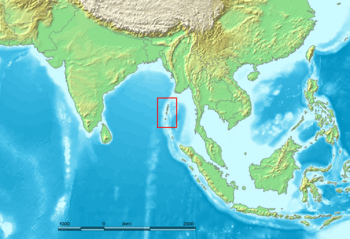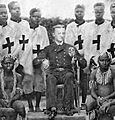Andaman Islands facts for kids

Location of the Andaman Islands in the Indian Ocean.
|
|
| Geography | |
|---|---|
| Location | Bay of Bengal |
| Coordinates | 12°30′N 92°45′E / 12.500°N 92.750°E |
| Archipelago | Andaman and Nicobar Islands |
| Total islands | 572 |
| Major islands | North Andaman Island, Little Andaman, Middle Andaman Island, South Andaman Island |
| Area | 6,408 km2 (2,474 sq mi) |
| Highest elevation | 732 m (2,402 ft) |
| Highest point | Saddle Peak |
| Administration | |
|
India
|
|
| Union territory | Andaman and Nicobar Islands |
| Capital city | Port Blair |
|
Myanmar
|
|
| Administrative region | Yangon Region |
| Capital | Yangon |
| Demographics | |
| Population | 343,125 (2011) |
| Pop. density | 48 /km2 (124 /sq mi) |
| Ethnic groups | Bamar Mainland Indians Jarawa Onge Sentinelese Great Andamanese |
| Additional information | |
| Time zone | |
| • Summer (DST) |
|
The Andaman Islands are a group of islands, also called an archipelago. They are part of India, located in the Bay of Bengal. This is off the eastern coast of India. The country of Myanmar is the closest land to the north. There are 572 islands in total. About 36 of these islands have people living on them. The Andaman Islands are a very popular place for tourists to visit.
Contents
How People Make a Living in the Andaman Islands
The people of the Andaman Islands mostly make money from fishing and farming. The islands also have other natural resources. Things like handicrafts, wood, wildlife, and tourism are very important for the economy.
Fishing Industry
Since the Andaman Islands are surrounded by water, fishing is a huge part of their economy. Many kinds of fish are caught here. These include clownfish, mackerels, tuna, and sardines. People also collect seashells.
Farming and Crops
Farming and food production have changed a lot recently. The government has made special plans to grow more food. This is important because there is not much land available. Farmers grow seasonal vegetables, oilseeds, and spices like pepper and cinnamon. They also grow rubber, palm, and cashew nuts.
Tourism and Travel
Tourism brings a lot of activity to the Andaman Islands. Many people see the Andamans as a great place for honeymoons. It is a tropical island with many fun water sports. Tourism also helps other businesses, like banks and handicraft shops.
In 2010, about 200,000 visitors came to enjoy the beaches. They loved the warm, tropical climate. Havelock Island and Jolly Buoy are famous for their beautiful coral reefs. These are some of the best places for diving in the area. Radhanagar Beach on Havelock Island was even called Asia's best beach by Time magazine. It was also listed as one of the top seven beaches in the world.
Fun Activities to Do
- Scuba diving
- Snorkelling
- Sea walking (walking on the seabed)
- Volcano tours
- Glass-bottom boat rides
- Parasailing
- Sea plane rides
Who Lives in the Andaman Islands?
In 2011, the total population of the Andaman Islands was 356,152 people. More than half of the people were male (53.25%), and the rest were female (46.75%). Many different languages are spoken here. These include Hindi, Bengali, Tamil, Malayalam, and Telugu.
This mix of languages happened because the British once used the islands as a prison colony. They brought many people, including prisoners and workers, to the islands. These people stayed and made the Andamans their home. This created a very diverse population.
Original Tribes of the Andamans
The original people of the Andaman Islands are called the Andamanese. They are a very small part of the population today, with fewer than 1,000 people. Long ago, there were ten different tribes living on the islands. Now, only about four of these tribes still exist.
- Great Andamanese: This was the main tribe of the Andamans. They once had over 5,000 people. Today, there are only about 52 of them left. They mostly speak Hindi and live peacefully with other island residents.
- Onge: This is a smaller tribe. There are now fewer than 100 Onge people.
- Jarawa: This is an ancient tribe that lives separately in the Andamans. We do not know their exact numbers. They do not want contact with the outside world.
- Sentinelese: This tribe is similar to the Jarawa. However, they are known to be more protective and do not welcome visitors.
Images for kids
-
A photograph of M.V. Portman with a group of Andamanese people
See also
 In Spanish: Islas Andamán para niños
In Spanish: Islas Andamán para niños













